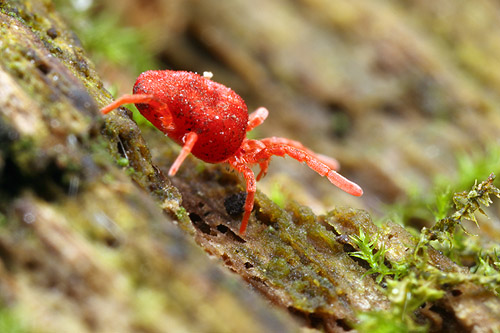
A velvet mite forages over a rotting log in Urbana, Illinois.
I don't photograph all that many mites, but if these miniature arachnids are your thing you should visit Macromite's amazing mite blog.
photo details: Canon MP-E 65mm 1-5x macro lens on a Canon EOS 50D
ISO 100, 1/250 sec, f13, flash diffused through tracing paper
- Log in to post comments
More like this
Pyramica clypeata
Urbana, Illinois
photo details: Canon mp-e 65mm 1-5x macro lens on a Canon EOS 50D
ISO 100, f/13, 1/250 sec, flash diffused through tracing paper
Prenolepis imparis - winter ant (queen)
Urbana, Illinois
Photo details: Canon mp-e 65mm 1-5x macro lens on a Canon EOS 50D
ISO 100, f13, 1/250 sec, diffused flash
While photographing a Lasius alienus colony in the park yesterday I noticed a red, round mite hanging off the leg of this worker ant. I'm glad we humans don't have parasites like these.
Perhaps if we're really nice, Macromite will tell us something about the little guy.
Photo details: Canon MP-E…
Looking like a trilobite, or perhaps a mutant millipede, a heavily armored beetle larva crawls through the leaf litter in an Illinois forest.  This predaceous insect belongs to the family Lycidae Lampyridae, the net-winged beetles fireflies.
photo details: Canon MP-E 65mm 1-5x macro lens on a…

I want one of those for my Acarium
That is an awesome picture of an awesome mite.
~Kai
I am going to come steal your camera!! What an amazing shot! I know how small these guys are, and for you to get that much detail is really a testament to your camera AND your ability. Well done!
Great depth of field for a lateral shot of something that small. You can see how legs I are used as antennae and the octopod mite is actually functionally hexapod (and you can also see the curved palps that are probably used to tap/taste the substrate as it walks along).
These mites are large and colourful enough to have a common name - red velvet mites - but under that name hides a heap of diversity and behaviours. What joins them all together is a terrestrial life style (water mites are their wet relatives), a parasitic hexapod larval stage, and an alternation of active and inactive stages during development. The red colour is due to carotenoids - probably originally for UV protection, but coopted into an aposematic warning in at least some species.
I'm guessing that this mite is a member of one of the five families in the Trombidioidea, in which case the larva would be an ectoparasite of an insect or other arthropod - little red 6-legged mites attached to soft cuticle by their mouthparts. If it were a Trombiculoidea, however, then you would know its larval stage as a chigger.
If I had a buck for every deleted and should be deleted photo of these red velvet mites I've taken, I'd be a lot richer than I am now. Awesome shot!
And thanks for the link.
I love your picture you are amazing at taking pictures!!!
This is the clearest picture of a red velvet mite i have ever seen! You could earn alot of money from taking pictures!
Red velvet mites forever!!!